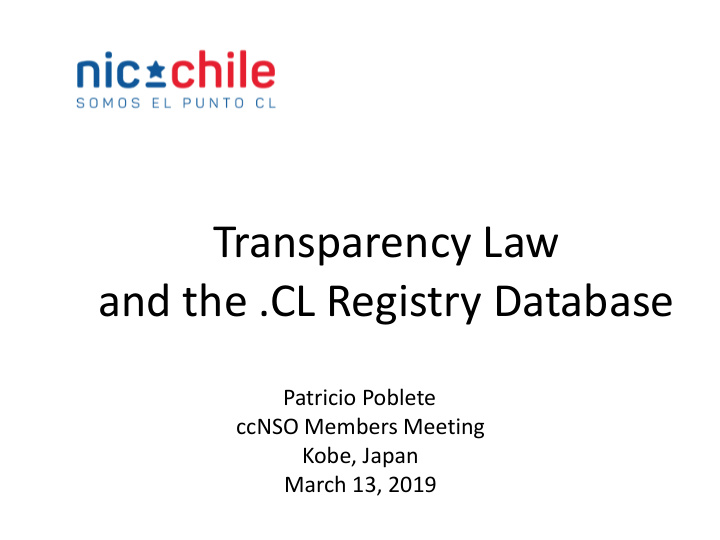



Transparency Law and the .CL Registry Database Patricio Poblete ccNSO Members Meeting Kobe, Japan March 13, 2019
Legal Context • NIC Chile, manager of .CL, is part of the University of Chile • The University of Chile is a public autonomous university • Transparency Law (20.285/2008) does not explicitly include public universities, but • After a long litigation, it was decided in 2011 that public universities are subject to Transparency Law �2
Active vs. Passive Transparency • Active Transparency: Some information must be published on the institutional website (e.g. salaries, financial information, purchases) • Passive Transparency: Any other information must be provided on request, with some exceptions (e.g. national security, personal information, disproportionate cost) �3
.CL domains are highly visible in Chile 100% 90% 80% 70% 60% 50% 40% 30% 20% 10% 0% gTLDs .CL Source: Zooknic/NIC Chile �4
The 2014 request • On October 2014 we received a request for the full list of domains names registered under .CL, plus the tax ID of the registrant • At the time, through WHOIS, this would have allowed the requester to scrape all the remaining information of the registrants �5
Notifying all affected customers • When providing information requested might endanger the rights of third persons, we have to notify them (by certified mail!) so they can object. If they do object, we cannot provide the information • Mailing several hundred thousands of certified letters would have been a huge and costly operation, so we emailed the registrants instead (a legally risky move) �6
�7
Aftermath • Within a couple of days, we received some 30 thousand emails of users objecting to their data being handed out to the requester • Big public outcry in social networks • As a consequence, the requester withdrew his request • The same thing did several copycats who had filed similar requests �8
Later similar requests • Since then, from time to time we have received similar requests, which we denied on the basis of endangering the rights of our users, and of the impossibility of properly notifying them • In a few cases, the requesters appealed to the Transparency Council, and in all such cases the Council supported our position • Until now… �9
The 2018 request • Here the request was for the full list of registered domain names. Nothing else. • We refused to provide the requested information, as we had done many times before. • The requester complained to the Transparency Council. • This time the Council found for the requester, and ordered us to provide the full list of domain names. �10
Why the change of mind of the Transparency Council? • The reasoning was that the would be no possible harm if the list contained only the domain names and nothing else • Users need not be notified, because they had already authorized the sharing of their information as part of the registration process • NIC Chile was already publishing a partial list of domain names, so why not publish it all? �11
What? No harm with only domain names? • Though much restricted, WHOIS can still be used to get more information, and the contact interface can be abused to spam the registrants or target them for phishing • Having a list of domain names makes life much easier for attackers who may scan the whole zone looking for vulnerable servers • Remember why NSEC3 had to be introduced �12
What? Users already authorized data sharing? • The Council cites from our terms and conditions: “[The registrant] authorizes [NIC Chile ] to make public the information of the domain name” • But the full clause is: “ [The registrant] authorizes [NIC Chile ] to make public the information of the domain name exclusively for purposes related to the management of the .CL registry and the operation of the DNS .” �13
What? Users already authorized data sharing? • The Council cites from our terms and conditions: “[The registrant] authorizes [NIC Chile ] to make public the information of the domain name” • But the full clause is: “ [The registrant] authorizes [NIC Chile ] to make public the information of the domain name exclusively for purposes related to the management of the .CL registry and the operation of the DNS .” �14 �14
What? List of domain names already published? • The domain name dispute policy of .CL encourages complaints to be brought within the first month of registration, and to that effect the list of new domain names of the last month is public. • This list includes less than 2% of the database, mostly not yet active domains. Hardly a basis to conclude that 100% should be public. • Abuses are already reported of this small sample, problem would be much worse if 100% public. �15
Survey: What would our colleagues do? REFUSE absolutely ACCEPT with conditions 2% ACCEPT unconditionally 16% 82% �16
• Conditions when accepting typically included - If the list is requested by a court or by law enforcement - For academic research - After signing agreement to guarantee no misuse • Only one ccTLD would unconditionally provide any and all information requested �17
Where are we now? • We filed an appeal at the next higher level (Court of Appeals) • The court could have refused to hear the case, but it accepted it and put it in its docket • We are waiting for a date for the case to be heard • If unsuccessful, we could still go to the Supreme Court �18
To be continued… �19
Recommend
More recommend